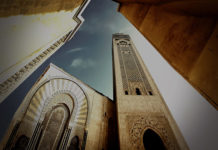Scholars of various schools of thought [1] differ greatly regarding the nature and essence of the soul (nafs). Is it a part of the physical body or a non-essential characteristic [2] of it? Is it an entity consigned to dwell within the physical body?, or is it an independent essence in itself? Is the nafs the same as the rûh (spirit)? Finally, what happens to the soul upon death? Is it confined to its body and its grave? If not, is it free to move about in the unseen spiritual world and on the earth? [3]
Regarding this subject, leading theologians of various sects have put forward a host of conflicting opinions. It would be beyond the scope of the present work to examine each and every view put forward by the various scholars; however, a brief mention of some of their opinions regarding this issue is necessary. The correct view [4] is given, supported by sound reason and statements from the Qurân and the authentic sunnah.
Various Incorrect Theories
According to the theologian, Abul-Hasan al-Asharî scholars differed regarding the rûh (spirit), nafs (soul) and hayâh (life force). An-Nadhdhâm, one of the leaders of the Mutazilah,[5] is attributed with having said that the nafs is the form of the rûh. He further claimed that the rûh is alive (i.e. animate) and exists independently. In contrast to his view, other scholars alleged that the rûh is a non-essential characteristic of the human being, unable to exist independently of itself. Still others opposed both of these views and claimed that it is not known what rûh is an essential characteristic or a non-essential characteristic.
The proponents of another theory claimed that man consists of a particular form contained within a physical body, however, they differed as to precisely what this form is. One group maintained that the form consists of four ingredients [6] from which the physical body originates and further develops. A second opinion was that it represents pure blood, free of impurities and contamination. Another view claimed that this form is the animate life in man, the sensual heat which pervades the body. And a fourth group proposed that the form is an essential element which causes all animate, living beings to function in a particular manner [7 ]yet is not separated from such beings and does not have a different structure. Although there are other opinions [8] defining this form within the physical body, the four previously mentioned views are a sufficient sample.
The Correct View
What is considered as the most accurate view regarding the nafs and the rûh is that of Ibn al-Qayyim [9] which is affirmed by Ibn Abul-Izz al-Hanafî in his commentary on al-Aqeedat at-Tahâwiyyah. [10 ]They base their position on various verses of the Qurân and the traditions of the Prophet as well as on sound logic and rational thought. According to them, man consists of a spirit and a body together. The spirit is an entity which differs from the physical, tangible body. It is a higher type of luminous (or light-like) being, alive and moving, and it penetrates the limbs, circulating through them as water circulates throughout the petals of a rose, as oil circulates throughout the olive and as fire circulates throughout the burning embers of coal. One may reasonably perceive the soul filling and occupying the body; its form, though non-physical, is molded into the bodys shape. [11]
The soul will maintain its penetration of the limbs of the physical body and continue to affect their sense, movement and will as long as these limbs remain sound. However, if they are overcome [12 ]and no longer accept the forces enacted upon them by the soul, the soul leaves the body and enters the spiritual world.
Qurânic Evidence
Certain circumstances of the human soul are mentioned in various places of the Qurân. [13 ]Two such examples follow:
| Allâh takes soul at the time of their death and [the souls] of those that do not die during their sleep. He retains those souls for which He has ordained death, whereas He releases the rest for an appointed term. [14] |
In this verse it is stated that there are only two points in time at which Allâh takes souls: at death and during sleep. [15 ]When one sleeps, Allâh separates the soul from the body. If He has decreed death for a person at this point, the separation becomes permanent and the body no longer functions. In the case of one for whom death has not been decreed at that time, the soul taken during sleep is returned to its respective body upon awakening. However, the soul for which Allâh has decreed death need not necessarily be taken during sleep but may be taken at a time other than sleep.
| If you could see when the wrongdoers taste the pangs of death and the angels stretch their hands out, [saying], Deliver up your souls. This day you will be awarded a degrading punishment. [16] |
Here it is stated that death is painful for the disbelievers. Although they are ordered to surrender their souls to the angels, they are unwilling; therefore, the soul must be forced out as it does not wish to meet its punishment.[17 ] The terms akhrijû anfusakum used in this Qurânic verse literally means expel or push out your souls, indicating that the soul becomes a separate entity from the physical body.
Evidence from the Sunnah
The sunnah is replete with descriptions of the state and nature of the human soul. These hadîths substantiate the view held by the dependable scholars of ahl as-sunnah. An example of the physical and psychological punishment awaiting the disbelievers occurs in the following portion of a long, authentically related hadîth:
| The Angel of Death [says], O you foul soul, come out to the anger and wrath of your Lord. The soul inside the disbelievers body is overcome by terrible fear [and does not want to deliver itself up], whereupon the Angel of Death violently pulls it out like multi-pronged skewers being yanked out of wet wool tearing with them the arteries and nerves. [18] |
It is also narrated in an authentic tradition:
| Umm Salamah reported: Allâhs Messenger entered upon Abû Salamah [i.e. his corpse], whose eyes were wide open. The Prophet closed the lids and then said, When the rûh [spirit] is taken out, the eyesight follows it [i.e., watches it ascend]. [19] |
These hadîths indicate in two ways that the soul is indeed a form. First of all, something must have a form in order to be grasped and extracted. And second of all, eyes can only visualize something that has a form. [20]
In another narration the Prophet described how the believers soul comes out of the body:
| The Angel of Death comes to the [dying] believer, sits at his head and says, O you good soul, come out and receive your Lords forgiveness and pleasure. Then the soul flows out effortlessly just as water flows from the mouth of a waterskin. [21] |
It is related in the same hadîth that as the soul is being carried up through the skies, the angels ask, Who is this? This question reaffirms the souls separate existence from the body. The angels would not pose such a question unless they had seen a distinct form.
In the following hadîth also affirms that the soul separates from the body:
| Abû Hurayrah narrated that Allâhs Messenger said: When the soul of the believer comes out [of its body], two angels receive it and rise with it towards the heavens, whereupon the inhabitants of the heavens say, A good soul has come from the earth. Allâh has blessed you and the body which you used to occupy. [22] |
The Arabic expression kunti tamureenah (you used to occupy) suggests that the soul inhabited the body, filling and possessing the whole of it. The souls dwelling within the body and departure from it clearly confirms the souls own entity.
Footnotes
[1] Not the four famous schools of fiqh (jurisprudence) but rather leading scholars and thinkers who represent various unorthodox sects, such as the Mutazilites, Rafidhites and philosophers. They have expressed various incorrect views and opinions on this and other subjects of aqeedah.
[2] In Arabic, aradh. According to the terminology of the philosophers, it refers to things which cannot exist independently, like color, smell, length, etc.
[3] See Kitâb ar-Rûh, p. 272.
[4] It is correct in the sense that it is not contrary to the beliefs of ahl as-sunnah, literally, the people of the established way or path (those who sincerely and firmly adhere to the Qurân and the authentic sunnah as their complete way of life). Indeed, there is little authentic information about the rûh. Referring to the rûh Allâh says in the Qurân: And you have not been given knowledge except for a little. Sûrah al-Isrâ, 17:85. (ed.)
[5] A misguided sect which introduced speculative dogmatics into Islâm. The school of thought is characterized by a slanted, so-called rationalistic approach to matters of faith. They interpret clear texts of the sharîah those from the Qurân and the sunnah in such a manner as to coincide with their preconceived notions based on what they termed sense. Ibn al-Qayyim has aptly refuted their views and those of other who have been influenced by philosophical thought foreign to Islâm. Whoever wishes to delve deeply into this aspect is referred to his celebrated treatise, Kitâb ar-Rûh, pp. 266-293, where he meticulously details his refutation with logic and reasoning.
[6] There is a philosophical view which claims that the human body originates from earth, air, fire and water. However, as mentioned in the Qurân and authentic sunnah, man originates from clay (i.e., earth).
[7] See al-Ghazâlîs treatise on the soul, Maârij al-Qudsfee Madârij Maârifat an-Nafs, pp. 27-35.
[8] Mentioned and refuted by Ibn Taymiyyah in Majmû al-Fatâwâ, vol. 3, pp. 30-35 and vol. 9, pp. 279-302.
[9] See his famous treatise dealing with the circumstances of the souls of the living and the dead, Kitâb ar-Rûh, pp. 249-250.
[10] See pp. 443-444.
[11] Descriptions of the spirit as light, its mode of penetration of the body, as well as its shape cannot be proven by the Qurân or the sunnah. As such, these descriptions can only be considered conclusions based upon their own understanding of the proofs. (ed.)
[12] Physical accidents, diseases or disorders may destroy the sound, physical harmony and delicate balance of the bodys functions, causing a person to die (the point at which the soul leaves the body). In any case, there need not always be a physical dysfunction for divine forces to cause death.
[13] Ibn al-Qayyim identifies over ninety supporting statements from the Qurân, the sunnah and sayings of the companions, which altogether give a complete picture of the nature of the human soul and the conditions which surround it. See Kitâb ar-Rûh, pp. 249-261 for details.
[14] Sûrah az-Zumar, 39:42.
[15] The separation which occurs during sleep is temporary, whereas, upon death, it is permanent. For details, see ar-Râzîs at-Tafseer al-Kabeer, vol. 26, p. 284.
[16] Sûrah al-Anâm, 6:93.
[17] See al-Qurtubîs commentary, al-Jâmiu li Ahkâm al-Qurân, vol. 7, p. 42.
[18] The full text is related in the section entitled The Taking of the Soul and the State of the Grave.
[19] Authentically related by Ahmad and Muslim.
[20] In his tafseer, al-Qurtubî affirms that the soul has a form. See vol. 15, p. 262.
[21] The full text is related in the section entitled The Taking of the Soul and the State of the Grave.
[22] Authentically related by Muslim.
Extracted with slight modifications from Mysteries of the Soul Expounded © 1994 Abul-Qasim Publishing House
(NOTE: If you want to build a strong and powerful relationship with Allah, check out Islamia TV, where you can watch Islamic speakers from across the globe deliver inspiring and motivational courses. Learn more at www.islamia.tv.)

















































